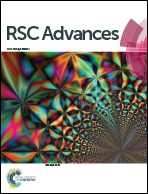One-step electrophoretic fabrication of a graphene and carbon nanotube-based scaffold for manganese-based pseudocapacitors†
Abstract
A reduced graphene oxide (rGO)/carbon nanotube (CNT)/MnOx based supercapacitor electrode has been fabricated successfully by a facile one-step electrophoretic deposition (EPD) method. During EPD, rGOs and CNTs form a three-dimensional nanoporous structure that works as a scaffold for manganese deposition. The weight loading and the film thickness can be easily tuned by varying the EPD time. Electrochemical measurements show that the as prepared electrode with a weight loading of 0.85 mg cm−2 exhibits a mass specific capacitance of 240 F g−1 at a current density of 0.5 A g−1. A relatively high areal capacitance (0.2 F cm−2) is achieved at the same current density and weight loading. The areal capacitance increases up to 0.27 F cm−2 as the weight loading is raised to 1.88 mg cm−2 at 0.5 A g−1. The excellent capacitive performance can be ascribed to the unique three dimensional structure created by CNTs and rGO that facilitates a more accessible electroactive area. Herein, 89% retention of the initial capacitance after 5000 cycles confirms that the as prepared electrode is a promising candidate for supercapacitor applications.


 Please wait while we load your content...
Please wait while we load your content...